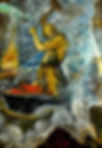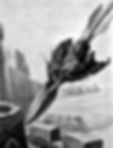Sons of Earth and Fire; The Strange Case of the Narts’ Metallic Men
- Ben Hellman
- Jun 1, 2021
- 8 min read
Updated: Jun 30, 2021

Batraz blasts down from the heavens, landing in the hearth of the Narts, the force of it burying him to his thighs, by artist Andrew Jones. Image commissioned for this article.
They are curiously kindred. Ossetian Shoshlan and his cousin, Batraz, are beings of steel and fire who become metal by being placed in a forge by a heavenly blacksmith. In the tradition of heroic tales of the northern Caucasus these figures also share a trove of contradictory and redundant traits that raise my myth-reading eyebrow and pose serious questions, starting with: why does a mythology need two metal men? They have alternately been understood as solar and storm figures, but they are also associated with stone, with fertility, and tantalizingly, with stars falling from the heavens and landing in the earth. Who are Shoshlan and Batraz, and where do they come from?
Ossetia is a region that straddles the Greater Caucasus mountain range south of Russia and north of Georgia. The people of Ossetia and their Circassian neighbors have a tradition of legends and myths about a superhuman race that mixed with gods and fought against monsters. These heroes go by the name of the Narts, a term that means manly hero, but is used in the tales almost as an ethnic or racial identity. A few months ago I interviewed translator and Caucasus expert John Colarusso about his translation of the Circassian Nart tales, but I enjoyed the stories so much I dove directly into Colarusso’s edition of the Ossetian Nart tales, which expanded on characters I found fascinating in the Circassian corpus: the men whose bodies were made of steel.
Shoshlan and Batraz have unusual origins and were both put into forges as children, turning their bodies into steel, each with a vulnerable spot. Shoshlan was born red hot from a stone, suggesting a myth about smelting iron, and blacksmithing. Shoshlan Batraz was born fiery hot from a lump in his father’s back, suggesting—I don’t know what! Batraz’s mother, a little person from the water people, divorces her husband for breaking a vow and “blows” the developing baby into his body. Batraz comes out of his father’s back and lands right in the sea, causing it to evaporate and beginning his short, strange career as an aquatic figure. Russian Ossetian scholar Vaso Abaev differentiated the tempering of Shoshlan and Batraz, suggesting that the element of wolf’s milk in Shoshlan’s hardening represented a shamanistic tradition, while Batraz was made steel through the raw technology of the forge. However, Batraz’s forging required dragon bones to superheat the forge. Surely this diverges from the notion that Batraz’s forging is meant to represent purely technological power.
Fiery Origins

Shoshlan and Batraz have their skin hardened in the forge by the heavenly smith Kurdalagon. Image by by Makharbek Tuganov.
After their forging, Shoshlan and Batraz’s paths diverge. Though he has plenty of heroic stories, Shoshlan’s steel skin does not figure prominently in them until his death, which exploits his only weakness, his knees, which were not hardened to steel. Batraz, however, is aglow in stories that recall his fiery birth and his steel skin. His steely body and its tendency to overheat feature prominently in tales. It makes me wonder whether the seemingly redundant detail of the blacksmith and hardening of their bodies represents a point in the oral storytelling where bards had begun to conflate the two. Perhaps writing the tales froze the figures in place before all of the stories about Shoshlan began to be associated with Batraz, at least in the Ossetian tales of the Narts.
Ossetian Batraz already has a buffet of curious attributes and associations that seem a bit too multifarious to me to belong to a single figure of myth. Myths help explain greater truths. The Scandinavians told the story of Thor’s hammer to explain thunder. The Greeks told the story of Persephone in the underworld to explain winter. It is hard to pinpoint just what Batraz’s many attributes would be used to explain. Born fiery, Baraz is doused in the sea and lives among his watery kin until he is coaxed out of the water to live with his father’s people. Stories of his childhood with the Narts repeatedly place him near the hearth, where he is often sooty and warming his feet. After he goes to the heavenly smith Kurdalagon to have himself hardened in the forge, the detail arises that he spends most of his time in the clouds and that when he is needed for help, one must send a bird as a messenger to call him down.
Projectile Hero

When he doesn't fly himself, he still finds a way into the air. “Batraz on the Arrow” by Makharbek Tuganov.
Batraz in battle is superhuman, but his kryptonite is his own heat. Though his steel fists pummel or crush adversaries—in one tale he is is even shot on a giant arrow and he breaches a castle wall like a cannonball—he overheats in combat and must cool himself. In one tale he has his horse kick him into the sea. Another tale begins with him on a glacier fresh from fighting. Batraz is finally defeated and killed when his enemies deprive him of a watery refuge and his one flesh intestine—hitherto unmentioned in the tales—burns up.
When I spoke to Colarusso he shared his theory that Batraz’s Circassian cousin Sosruquo (rendered Shoshlan in the Ossetian corpus) might share a common heritage with those nigh-invulnerable figures of European legends, Achilles, Cuchulainn and Sigurd, all of whom are either dark-skinned or connected with a blacksmith in some manner. At the time we were only discussing Colarusso’s translation of the Circassian Nart tales, as I had not yet read the Ossetian tales. Everything Colarusso said of Circassian Sosruquo applies even more appropriately to Ossetian Batraz. Batraz is described as dark and dusty from the hearth he plays in as a child. He relates more directly to the Irish Cuchulainn, who overheats in battle, and in one tale is thrown in successive barrels of water, which explode or completely evaporate until his body is cooled down. But these details only tie the Circassian Shoshlan and Ossetian Batraz to the forge.
Shoshlan’s Circassian tales, while omitting much of Ossetian Batraz’s superheroic flying and overheating, more than once place him in the realm of fertility figure. He recovers grain stolen by an ogre-like figure in one tale. In Circassian and Ossetian corpuses, when his enemies cannot kill him, they simply bury or entomb him alive, where he goes on living forever after blessing various animals with his strengths. Ossetian Batraz likewise has the markers of a fertility figure. In one tale he melts a glacier to cool his overheating body, the water runs from his face and falls on the earth. As already noted, he evaporates a sea when he is born, and Earth’s system of precipitation relies on evaporation. While he is not caught, Batraz’s enemies do try to bury him once and notably, in “Batraz and Tykhyfyrt Mukara” when “[Batraz flings] himself down from the heights and [falls] right into the fireplace of the Narts” landing so hard he buries himself “up to the middle of his thighs in the hearth.”
In a private email, Colarusso said that Batraz does seem to be an offshoot of Circassian Shoshlan and also that in formalizing the Ossetian corpus into the coherent cycle we have today, Abaev stripped out old details, the accretion of oral transmission over many generations, that would confuse readers. In reading and being able to compare the Ossetian and Circassian tales in Colarusso’s collections, this has been my impression. The Circassian tales retain a wildness that is embodied in details that seem significant, but go unexplained and may even contradict one another. This is not a criticism of the Ossetian corpus, which does have fun mysteries and contradictions, particularly when previously unmentioned divine figures make appearances.
Sky Iron

Iron does occasionally fall from the sky in the form of hot, burning meteorites. “The Terrible Comet” from the Augsberg Book of Miracles, 16th century, private collection, Wikipedia.
While Batraz and Shoshlan may have come by their metal and accompanying traits via associations with thunder and the earth’s fertility, another, wilder idea has occurred to me. I’ve left it for the end of this piece to segregate it from my firsthand reading and reporting of details from the Circassian and Ossetian Nart corpuses because I feel it is fanciful, but I also feel it is worth thinking about. And while he did not go so far as endorsing the theory, Colarusso (via email) did support the premise, which is that the earliest iron to be forged was that to be found in meteorites. It was hard for me to read about a figure whose early tales so connected him with fire and metal and then so abruptly shifted to having him crash down from heaven and embed himself in the earth without thinking about meteorites, those rocks that breach our atmosphere and strike the earth. I had remember in the Circassian corpus another story that seemed to be about a meteorite, associated with Shoshlan. In “How Sasruquo Plucked Down a Star” Sasruquo (a Circassian variant spelling of Shoshlan) fires a lead-weighted arrow into the sky and pulls it down to earth for the purpose of warming his comrades, who are freezing. Later in the same tale, when he returns with a brand of fire to make a fire, he is described as “glowing like a falling star.” The story struck me as unusual in that I could not recall other legends that seemed to be about meteorites. Could fiery, stelling Batraz’s (or Shoshlan’s) origins have been in a hunk of hot metal that fell from the sky?
With the origins of Shoshlan and Batraz so intertwined with the forge and metal, it is worth considering that before the advent of smelting, meteoric iron was the only source for the metal. Artifacts made of meteoric metal have been found in Asia, Africa and the Americas. The Tutankhamun dagger, found in the Egyptian king's 14th century BCE tomb, is only one of the known examples of meteoric iron being forged into an object. Inuit hunters in the Americas are known to have topped a narwhal tusk with meteoric metal and an axe head made of the metal was found in Ugarit in Syria. The articles I’ve found on the worship of meteorites are dated, but more than one scholar has written of instances of meteorite worship by peoples around the globe. Hubert Newton’s “The Worship of Meteorites,” published in Nature in Aug. 12 1897, considers the instance of the black stone in the Kaaba of Mecca (which has never been proven to be a meteorite) and other tales from antiquity. Oliver Farrington, in the Journal of American Folklore, 1900, tantalizingly, relates a story that proves that meteorites have sometimes been considered the physical remains of thunderbolts. This would connect Batraz and Shoshlan’s storm god statuses with hunks of hot metal falling from the sky. Farrington quotes from a letter to the British Museum that accompanied the Nejed meteorite, from Najd, Saudia Arabia. The letter writer Hajee Ahmed Khane Sarteep, refers to the meteorite and other meteorites as “thunderbolts.” (From “The Worship and Folk-lore of Meteorites”)
I don’t mean to lay out a treatise on meteoric worship in this piece, and I also can’t think of another instance where a meteorite was personified as Shoshlan or Batraz would have been if this theory could be proven. It seems unlikely that such characters would arise only in one mythology, but the correspondances seem worth studying. While the theory seems, at the moment, farfetched, it is fun and I will continue to research the matter.
